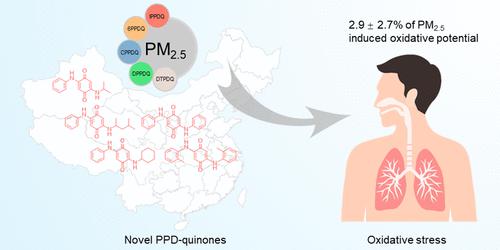当前位置:
X-MOL 学术
›
Environ. Sci. Technol. Lett.
›
论文详情
Our official English website, www.x-mol.net, welcomes your
feedback! (Note: you will need to create a separate account there.)
p-Phenylenediamine-Derived Quinones as New Contributors to the Oxidative Potential of Fine Particulate Matter
Environmental Science & Technology Letters ( IF 8.9 ) Pub Date : 2022-08-10 , DOI: 10.1021/acs.estlett.2c00484 Wei Wang 1 , Guodong Cao 1 , Jing Zhang 1 , Zhifeng Chen 2 , Chuan Dong 3 , Jianmin Chen 4 , Zongwei Cai 1
Environmental Science & Technology Letters ( IF 8.9 ) Pub Date : 2022-08-10 , DOI: 10.1021/acs.estlett.2c00484 Wei Wang 1 , Guodong Cao 1 , Jing Zhang 1 , Zhifeng Chen 2 , Chuan Dong 3 , Jianmin Chen 4 , Zongwei Cai 1
Affiliation

|
Atmospheric fine particulate matter (PM2.5) has been linked to multiple adverse outcomes, where redox-active species-induced oxidative stress is recognized as an important driver of its biotoxicity. Previous studies have proven that the oxidative potential (OP) is a relevant metric for specific acute PM2.5 health effects and is associated with various toxicants, especially organic quinones. However, discrepancies between OP induced by the known components and its total levels caused by PM2.5 remain. Here, we investigated the OP values of a suite of emerging contaminants, five p-phenylenediamine-derived quinones (PPD-quinones), in PM2.5 using the acellular dithiothreitol (DTT) assay and evaluated their contributions to the total PM2.5-induced OP in five megacities in China. N-(1,3-Dimethylbutyl)-N′-phenyl-p-phenylenediamine-quinone (6PPD-Q), a highly toxic quinone responsible for “urban runoff mortality syndrome”, was found to exhibit moderate OP with a DTT consumption rate of 1.70 μM min–1 μM–1. Meanwhile, it is noteworthy that the estimated OP contribution of the five PPD-quinones was 2.9 ± 2.7% of the total PM2.5-induced OP. This is the first study that reveals a considerable OP induced by the emerging PPD-quinones in urban PM2.5. The data improve our understanding of the toxicity of both PM2.5 and PPD-quinones, which is illuminating for further assessment of the environmental risk they pose.
更新日期:2022-08-10















































 京公网安备 11010802027423号
京公网安备 11010802027423号